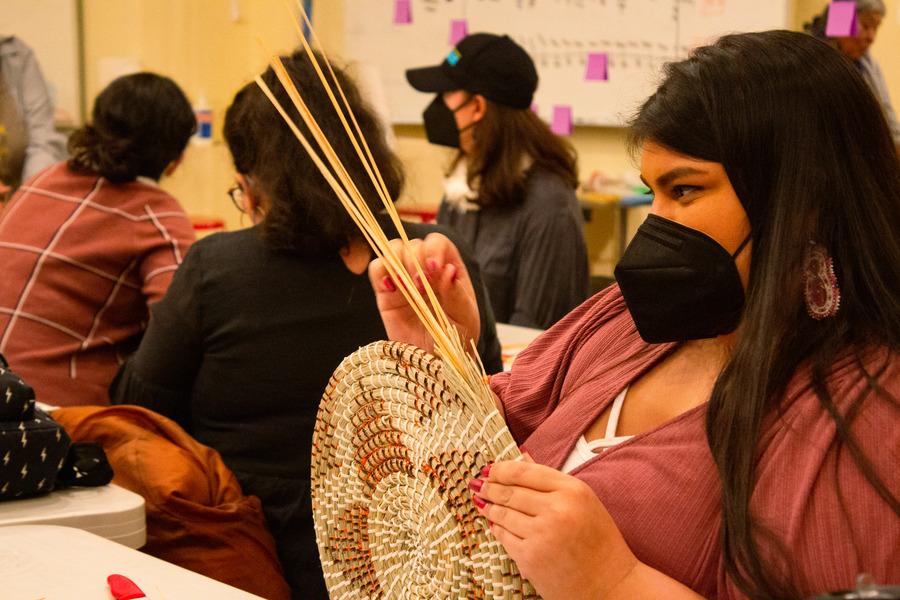One of the proposed solutions to the subsistence debate has been to base subsistence eligibility on individual need and issue permits to needy individuals. Another proposal has been to link a subsistence priority to household income, based on an assumption that households with more cash have less need for subsistence. However, both of these approaches would undermine the subsistence systems in rural Inupiat villages in northwest Alaska which are organized within extended family networks.
In rural Alaska villages, family groups harvest, process, and share subsistence foods. This type of economic organization has been called a domestic mode of production and distribution, because the economic groups are organized along kinship lines.
The domestic mode can be illustrated by the community of Wales, a small Inupiat community of 161 people on the Bering Sea coast in northwest Alaska. The Inupiat people come from a long hunting tradition, relying on bowhead whale, seal, walrus, caribou, and other species for survival. Households in Wales consented to be surveyed in 1994 through a cooperative project with Kawerak (a regional Native nonprofit corporation), the National Park Service, and the Alaska Department of Fish and Game, Division of Subsistence. According to the survey, 93% of Wales households used wild foods the previous year, with an estimated average annual harvest of 2,268 edible pounds per household (744 pounds per person). Marine mammals were by far the largest source of wild foods, accounting for 78% of the total harvest.
Family Networks of Sharing
To describe the social organization of subsistence production and distribution, researchers counted the number of times a household shared wild foods or pooled labor with another household. Based on those counts, a network of cooperation between households was constructed. Sharing labor and wild foods was found to occur within four main groups and four smaller cooperative groups. The eight cooperative groups were all extended families, except one that was comprised of two unrelated families and a teacher. Extended family groups typically included three or four generations descended from common ancestors with elder parents heading a household and children and grandchildren heading other households.
Most subsistence production and distribution occurred within one of these cooperative groups. Of the 352 reported instances of ex-household production, 76% occurred between households within one of the extended family groups. These percentages do not take into account production by a household for itself. If all 916 instances of production by households are considered, then 91% of all production occurred between households clustered within one of the extended family groups.
Subsistence and Income
Subsistence fishing and hunting requires income to purchase equipment such as skiffs, outboard motors, snow machines, fuel, rifles, and ammunition. The relationships of household income and subsistence production are complex and vary substantially between households.
The two highest per capita subsistence harvests in the community were reported by the sixth and seventh highest income households. At the other end of the income scale, the six households reporting the lowest per capita incomes all reported substantial subsistence harvests. Their per capita harvests, however, were smaller than the households at the high end of the income scale. The relationship between income and subsistence production was not simple. Within most production groups, the higher income household produced higher amounts of subsistence foods.
Traditional Patterns in the Modern World
The extended family groups in Wales in 1994 resembled Inupiat social organizations from the 19th century that anthropologist Ernest Burch has called "local families." The core of each extended family group is commonly a demographically-mature household unit and has been called a "super-household" because it produces most of the wild foods in the community. Attached to the core household through kinship ties are households in other developmental stages, such as elder parents or children just starting out. These other households are relatively less productive than the core household because they are not physically able, smaller, lack skills or equipment, or are limited by the demands of caring for small children. Subsistence foods typically flow out from the core household to the other households in a group, enabling all households to maintain a higher standard of living.
This traditional system of production and consumption of subsistence foods continues to work well for the Inupiat of northwest Alaska. While other rural communities may differ from Wales in the details of subsistence group composition, the domestic mode of production using kinship as its organizing principle is a common feature of most rural subsistence systems in Alaska.
The Wales findings support observations by other researchers about the nature of subsistence economies in Alaska and offer additional insight into the organization of subsistence production. Anthropologist Robert Wolfe has observed that 30% of the households in a given rural Alaska community typically account for 70% of the subsistence harvest. In Wales, the proportion of highly productive households was even smaller-20% of the households accounted for 70% of the community's harvest.
In addition, super-households were in a mature stage of development, with older, but able parents, and with adult children living at home. These households had an abundance of labor. Some adults could hunt and fish, one or two adults could work for wages, and older children could be responsible for child care.
The super-household theory and the Wales findings do not support some recent proposals in Alaska to provide a subsistence priority only to needy individuals or to low income households. The Wales analysis showed that the lowest income sector of the community harvested barely a quarter of the community's total subsistence harvest. The analysis of production groups showed that within a majority of the groups, households with higher per capita incomes accounted for most of the harvest. These are not wealthy households. The average annual household income in Wales in 1994 was about $31,000, equivalent to the purchasing power of about $13,000 in Anchorage.
A subsistence law that denies the subsistence priority for the most productive households could have a devastating affect on Alaska's rural communities. Many of the most productive households would be above the income limits being proposed in law. Such a law would not reflect the economic realities of subsistence in rural Alaska, where subsistence production and distribution are organized among extended family groups.
References
Burch, Ernest S. Jr. 1975. Eskimo Kinsmen: Changing Family Relationships in Northwest Alaska. St. Paul: West Publishing Company.
Magdanz, James and Annie Olanna. 1984. Controls on Fishing Behavior on the Nome River. Technical Paper No. 102, Juneau: Alaska Department of Fish and Game, Division of Subsistence.
Wolfe, Robert J. 1987. The Superhousehold: Specialization in Subsistence Economies. Juneau: Division of Subsistence, Alaska Department of Fish and Game.
Article copyright Cultural Survival, Inc.



